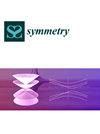Shifting Pattern Biclustering and Boolean Reasoning Symmetry
IF 2.2
3区 综合性期刊
Q2 MULTIDISCIPLINARY SCIENCES
引用次数: 0
Abstract
There are several goals of the two-dimensional data analysis: one may be interested in searching for groups of similar objects (clustering), another one may be focused on searching for some dependencies between a specified one and other variables (classification, regression, associate rules induction), and finally, some may be interested in serching for well-defined patterns in the data called biclusters. It was already proved that there exists a mathematically proven symmetry between some patterns in the matrix and implicants of data-defined Boolean function. This paper provides the new look for a specific pattern search—the pattern named the δ-shifting pattern. The shifting pattern is interesting, as it accounts for constant fluctuations in data, i.e., it captures situations in which all the values in the pattern move up or down for one dimension, maintaining the range amplitude for all the dimensions. Such a behavior is very common in real data, e.g., in the analysis of gene expression data. In such a domain, a subset of genes might go up or down for a subset of patients or experimental conditions, identifying functionally coherent categories. A δ-shifting pattern meets the necessity of shifting pattern induction together with the bias of the real values acquisition where the original shifts may be disturbed with some outer conditions. Experiments with a real dataset show the potential of our approach at finding biclusters with δ-shifting patterns, providing excellent performance. It was possible to find the 12×9 pattern in the 112×9 input data with MSR=0.00653. The experiments also revealed that δ-shifting patterns are quite difficult to be found by some well-known methods of biclustering, as these are not designed to focus on shifting patterns—results comparable due to MSR had much more variability (in terms of δ) than patterns found with Boolean reasoning.移动模式双聚类与布尔推理对称
二维数据分析有几个目标:一个目标可能对搜索相似对象的组(聚类)感兴趣,另一个目标可能专注于搜索指定对象与其他变量之间的一些依赖关系(分类、回归、关联规则归纳),最后,一些目标可能对搜索数据中定义良好的模式(称为双聚类)感兴趣。已经证明了矩阵中的某些模式与数据定义布尔函数的隐含式之间存在数学证明的对称性。本文为一种特殊的模式搜索提供了新的视角- δ移模式。移位模式很有趣,因为它解释了数据的持续波动,即,它捕获了模式中所有值在一个维度上向上或向下移动的情况,保持了所有维度的范围幅度。这种行为在真实数据中非常常见,例如基因表达数据的分析。在这样一个领域中,基因的一个子集可能会为一个子集的患者或实验条件而上升或下降,从而确定功能上连贯的类别。δ移位模式满足移位模式归纳的需要,同时也满足实际值采集的偏差,而原始移位可能受到某些外部条件的干扰。真实数据集的实验显示了我们的方法在寻找具有δ移位模式的双簇方面的潜力,提供了出色的性能。在MSR=0.00653的112×9输入数据中可以找到12×9模式。实验还表明,δ移位模式很难被一些著名的双聚类方法发现,因为这些方法并不是为了关注移位模式而设计的——与布尔推理发现的模式相比,MSR的结果具有更多的可变性(就δ而言)。
本文章由计算机程序翻译,如有差异,请以英文原文为准。
求助全文
约1分钟内获得全文
求助全文
来源期刊

Symmetry-Basel
MULTIDISCIPLINARY SCIENCES-
CiteScore
5.40
自引率
11.10%
发文量
2276
审稿时长
14.88 days
期刊介绍:
Symmetry (ISSN 2073-8994), an international and interdisciplinary scientific journal, publishes reviews, regular research papers and short notes. Our aim is to encourage scientists to publish their experimental and theoretical research in as much detail as possible. There is no restriction on the length of the papers. Full experimental and/or methodical details must be provided, so that results can be reproduced.
 求助内容:
求助内容: 应助结果提醒方式:
应助结果提醒方式:


